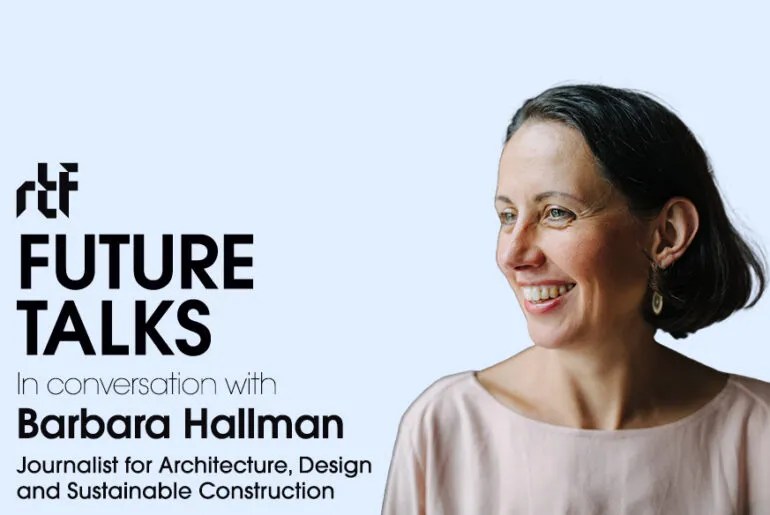Welcome to Future Talks by RTF, where we engage in conversations with the pioneers who breathe life into design stories. Barbara Hallman, an architecture and design journalist primarily based in Germany, born in the now non-existent GDR in 1979. Her passion lies in exploring the intricacies of cities, villages, and landscapes, pondering on how people inhabit, embrace, and shape their built environment and cultural landscapes.
Every structure, from houses to bus stops, every piece of furniture, be it a chair or a vase, contributes to the essence of our surroundings. What fascinates her the most is the intersection of language and architecture—two powerful forces that independently, and even more so, collectively, leave a lasting impact on individuals.
Join us as we unravel the stories that shape the future of design and architecture.
RTF: Hi Barbara, We are glad to have you as a guest on Future Talks by RTF. Thanks for joining us. Tell us about your professional journey so far and what factored your choice of going freelance.
Barbara: I studied “European Media Culture” at the Franco-German University of Applied Sciences in Lyon and Weimar. I then trained as a journalist in German public television and radio. Since then, I have worked alternately as a freelancer and as an employee. For almost ten years now, I’ve only worked freelance. There are three reasons for this: I have a wide range of topics to work on. Secondly, I can freely organize my location and working hours. And I work with many different clients – that’s interesting and keeps me flexible.
RTF: What is your process of producing architecture and design stories?
Barbara: It depends very much on who I’m working for. Sometimes clients come to me and present me with a project or a person they want to report on in their medium. Sometimes it’s me who finds topics and offers them. For me, stories are always about the people behind them: What drives them?
RTF: What makes a story worth publishing?
Barbara: It has to be surprising. It has to give those who read it a new perspective.
RTF: What are your views about the global architectural landscape? Where is it headed?
Barbara: That’s a difficult question. I believe that architecture is getting more and more lost in very complex regulations that leave little room for real experimentation. For me, good architects are those who know how to use this small space to create something innovative that will stand the test of time and set standards for future projects. And which at the same time makes the public – however small it may be – think about how we want to shape our built environment.
RTF: What are the essential components of a media kit according to you?
Barbara: Photos with a great aesthetic that are nevertheless lively. Easy-to-understand texts that focus the content on those who are supposed to read them. What use is a text in architectural language that is not understood by the general public?
RTF: How do you like to be pitched? What is the ideal number of follow-ups?
Barbara: I always enjoy receiving commissions from new cooperation partners – because there are always new people and usually new topics behind them. That fascinates me. If it is possible to establish a long-term professional relationship because everybody likes working together – why not?
RTF: What is your motivation? What keeps you going?
Barbara: With every new assignment, I learn a little more about how our world works. That may sound egotistical – but don’t we all actually work because we like what we do?
RTF: What are your top tips for architects wanting to get featured?
Barbara: Of course, spectacular projects work best, preferably in exciting locations. But even with smaller projects you can often find that one point that is special. But you should always ask yourself: What can and should I gain if my project is printed? Follow-up orders? Being invited to competitions? New employees? Turn the office into a brand?
RTF: What are some challenges that general exchanges with creatives and designers present?
Barbara: Unfortunately, many creatives – and I’m thinking in particular of smaller architecture firms – have hardly any focus on their public relations work. Branding is not yet a real priority for architecture firms, especially in Germany, Austria and Switzerland. Awareness of this is only slowly growing. In my view, this is also due to the fact that management aspects only play a very minor role in the training of architects
RTF: With almost 20 years in the industry, what would be your advice to young writers aspiring to take a plunge into design magazines? And what additional skills would you advise them to develop?
Barbara: I believe they should master three things: Firstly, dealing with artificial intelligence. Secondly, excellent writing skills. Thirdly, very good research skills. Because: AI can easily write proper texts with all the information it finds on the Internet. But if we write excellent texts with information that can’t be found on the Internet – then we journalists will still be needed.
RTF: How has your job influenced you creatively? What are your plans for the future and what are some off-the-table habits that keep you motivated?
Barbara: My job has influenced me to the extent that I never let anything into my house that doesn’t look good. In the future, I want to work even more internationally and travel more again – which wasn’t possible because of Covid. What motivates me? I learn something new with every job and I never want to stop.
Thank you so much for doing this interview with us. It has been a pleasure getting to know about you and your work. We’re sure that your insights will be highly valuable to our audience which includes architects and design students. We look forward to publishing this interview on our website soon.












